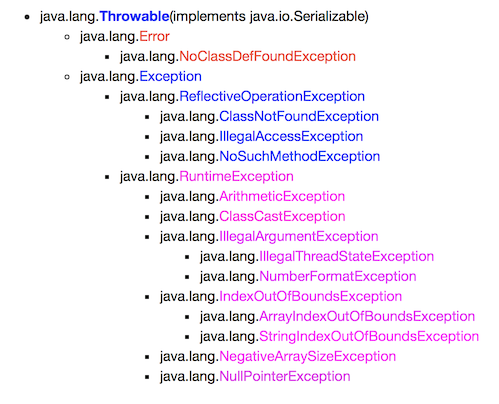Java中的异常处理一直是困扰着我。比如catch并throw一个异常的best practice是什么?checked和unchecked异常的区别和使用,异常和错误该如何处理。最近在工作中连续出现了一些与异常相关的一些issues,才发现需要进行一些整理和总结了。
如图所示,java错误,异常类都是源于一个叫做Throwable的基类,只有该类及其子类的实例对象才可以被JVM进行throw操作。且也只有该类及其子类能作为catch语句的输入参数。
一个Error类及其子类表明一个合理设计的应用不需要,也不应该catch的一些严重问题。多数时候这些错误是来自一些异常情况。如AnnotationFormatError,当一个Annotation解析器试图读取一个类文件的Annotation时发现其是malformed而throw的Error。LinkageError则是指当一个类依赖的一些类在compile阶段之后有了一些非兼容性的改变,然后导致依赖其的类出现链接错误,NoClassDefFoundException便是其一个子类。当然还有经典的VirtualMachineError,其一般在java虚拟机broken或是没有足够的资源供其运行时throw。
从编译时异常检测的角度,Error类时unchecked异常。通畅其表明环境或是程序设计的一个严重bug。
另外一个Throwable的子类是Exception类。其是所有异常类的父类。跟Error相对应,Exception类通常指一个合理设计的应用可能需要catch的。
从编译时异常检测的角度,大多数的Exception类都是可检测异常,除了RuntimeException及其子类。一些常见的运行时异常,如NullPointerException,当一个应用试图使用本该是一个实例对象,而实际为null值时抛出(例如,调用一个null对象的方法,域值)。NoSuchElementException,当一个应用调用枚举类型中nextElement方法,在没有更多元素时抛出。IllegalArgumentException则表明一个方法传入了非法或者不合适的参数。其他常见的还有CastClassException,ArithmeticException等。如除数是0时,ArithmeticException便会抛出。
[1.] Oracle Java API.
[2.] Top 10 questions about Java Exception.
[3.] Checked Exception Practise
[4.] Oreilly.com.
[5.] Howtodoinjava
So long, and thanks for all the fish.